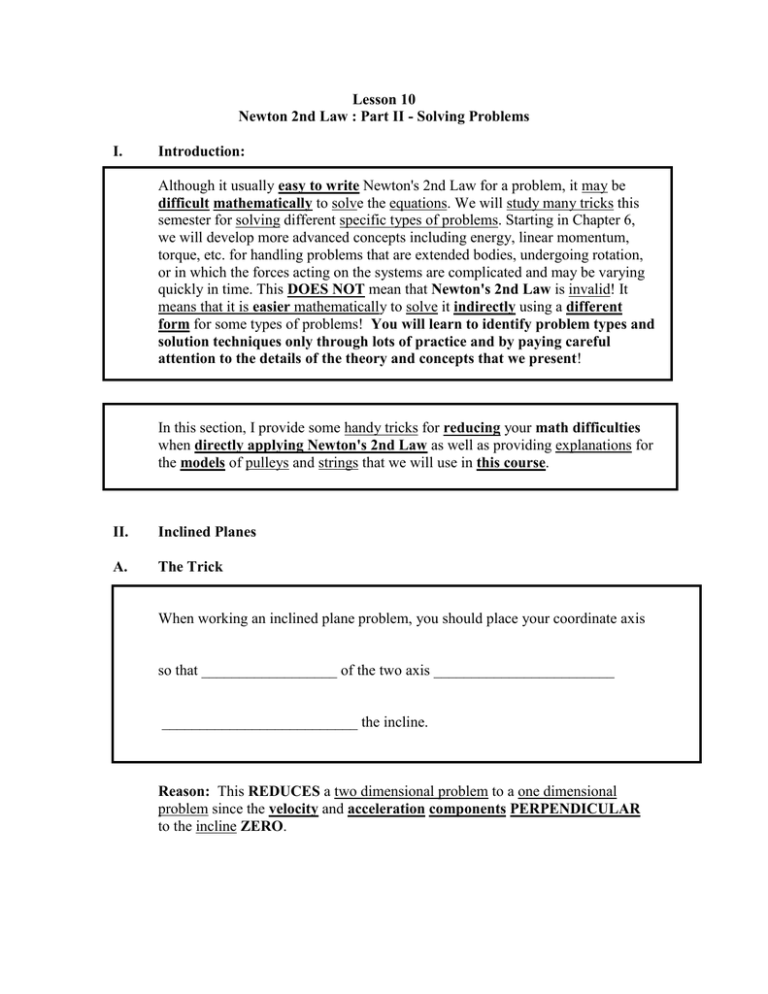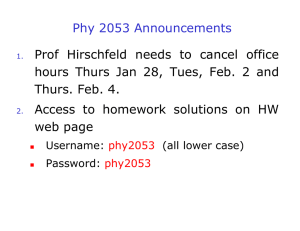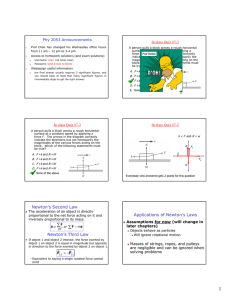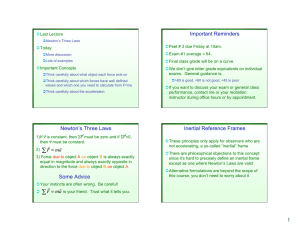Lesson 10 Newton 2nd Law : Part II - Solving Problems I.
advertisement

Lesson 10 Newton 2nd Law : Part II - Solving Problems I. Introduction: Although it usually easy to write Newton's 2nd Law for a problem, it may be difficult mathematically to solve the equations. We will study many tricks this semester for solving different specific types of problems. Starting in Chapter 6, we will develop more advanced concepts including energy, linear momentum, torque, etc. for handling problems that are extended bodies, undergoing rotation, or in which the forces acting on the systems are complicated and may be varying quickly in time. This DOES NOT mean that Newton's 2nd Law is invalid! It means that it is easier mathematically to solve it indirectly using a different form for some types of problems! You will learn to identify problem types and solution techniques only through lots of practice and by paying careful attention to the details of the theory and concepts that we present! In this section, I provide some handy tricks for reducing your math difficulties when directly applying Newton's 2nd Law as well as providing explanations for the models of pulleys and strings that we will use in this course. II. Inclined Planes A. The Trick When working an inclined plane problem, you should place your coordinate axis so that __________________ of the two axis ________________________ __________________________ the incline. Reason: This REDUCES a two dimensional problem to a one dimensional problem since the velocity and acceleration components PERPENDICULAR to the incline ZERO. EXAMPLE: A block of mass M slides down a frictionless incline plane whose angle of inclination is 30 degrees as shown below: 5m 30 Assuming that the block starts initially at rest at a height of 5 m, what is its speed when it reaches the bottom of the incline? Solution: There is no plug and chug formula to directly solve the problem! The problem requires you to synthesize several different concepts that we have previously covered this semester and apply them to this problem. Thus, you must have a good knowledge of the individual concepts as well as the ability to synthesize the material. This is a higher level reasoning (more difficult) skill that you are suppose to be developing through out this course!! Step I : Draw an FBD for the Mass Using Our Axis Trick Step 2: Write and Solve Newton II for This Problem Step 3: Check Our Work To See If It Makes Sense (Units, Physical Implications) Step 4: What Can We Infer From The Acceleration Step 5: We Use ________________________________ Step 6: Check Your Work To See If It Makes Sense Although the specific steps in every problem may be different, the procedure for solving problems is the same. You should always have: 1) a good drawing 2) write down all known quantities as well as what you are required to find 3) identify the important physics concepts that are involved 4) write down any physics equations that might be helpful based upon 3) 5) Solve using definitions and the physics identified in 3). If no direct solution procedure presents itself then begin by solving for any unknown physical quantity and repeating steps 3) through 5) until a direct solution path can be found. III. Physics Strings A. Unless the problem specifically states otherwise, you will consider any string in a physics problem to be a physics string! B. Physics strings are ______________________ and _______________________ C. The properties of a physics string tell us that: 1) The magnitude of the force on a physics string is the SAME at _____________________ __________________ of the string. 2) Two objects are connected by a physics string have the SAME ________________________ and PROOF: ________________________ D. Physics Strings VS Real Strings A physics string is an approximation (model) of a real string (cable/wire). Many strings have negligible mass compared to the connected objects. Thus, the strings mass can be neglected. Secondly, many strings are only slightly stretched compared to their length or other important dimensions (distance traveled, etc.) during actual applications. Thus, they can be approximated as unstretchable with small errors. This is like neglecting air friction in projectile motion. We are approximating to simplify the math. However, we should always be on the look out for the possibility that our approximations are invalid. For example, it is a bad approximation to ignore the mass of a steel bridge cable or the stretching of a rubber band. If the cable's mass can not be neglected then we add another block to represent the cable. This will add another free body diagram to the problem! E. Important Facts: STRINGS CAN'T PUSH!! The only purpose of a string is to connect the motions of two different objects EXAMPLE: Two mass M1 and M2 are connected by a rope. A boy pulls with a force of 10 N on a rope connected to M1 as shown below. Given that the mass of M1 and M2 are 5.00 kg and 3.00 kg respectively, what is the acceleration of mass M2? M2 M1 T = 10 N Solution: Since M1 and M2 are connected by a physics string, they will have the ______________ __________________________. Furthermore, they can be considered to be a _________________ body of _________________ ______________________. Using this NEW Object as my system, I draw the following free body diagram: Now applying Newton's II Law, we have that IV. Physics Pulleys A. Unless we are told differently in a problem, we will consider all pulleys to be physics pulleys. B. Physics pulleys are _________________________ and _____________________ C. Purpose of Pulley The Purpose of a Physics Pulley Is To Redirect The Direction of A Force. D. A string ALWAYS enters/leaves _______________________ to the pulley. Thus, the _____________________ is __________________________ to the _________________________ of the pulley. E. The Trick - "The Rule of The Gun" When two objects are connected by a string, their motion is linked. If the string passes over a pulley, you will need to link the equations of motion for the two object's. This is most easily done by linking the coordinate axes of the objects' free body diagrams! At West Point, they call this "the rule of the gun." Step 1: Arbitrarily choose the coordinate axis for one of the two bodies. Step 2: Place the thumb of your right hand along the +y-axis and your index finger along the +x-axis. Step 3: Follow the string over the pulley to the next object. Your thumb and index fingers now point in the +y and +x-directions for this object's coordinate axis. Step 4: Place and label the coordinate axis on the free body diagram of the second object based upon your results in Step 3. Step 5: Solve the problem like any other Newton II problem. Note: If you don't use the "rule of the gun" then you will have to connect the Newton II equations of object I and II manually. You will have four acceleration components, velocity components, etc. and will have to write constraint equations. For instance, you might have ay1 = ax2 Thus, the acceleration of object #1 in the y-direction is equal to the acceleration of object #2 in the x-direction. The subscripts are important! The "rule of the gun" removes all of this algebra! EXAMPLE: What is the acceleration of the 3 kg mass shown below assuming that the table is frictionless? 3 kg 12 kg 5 kg




